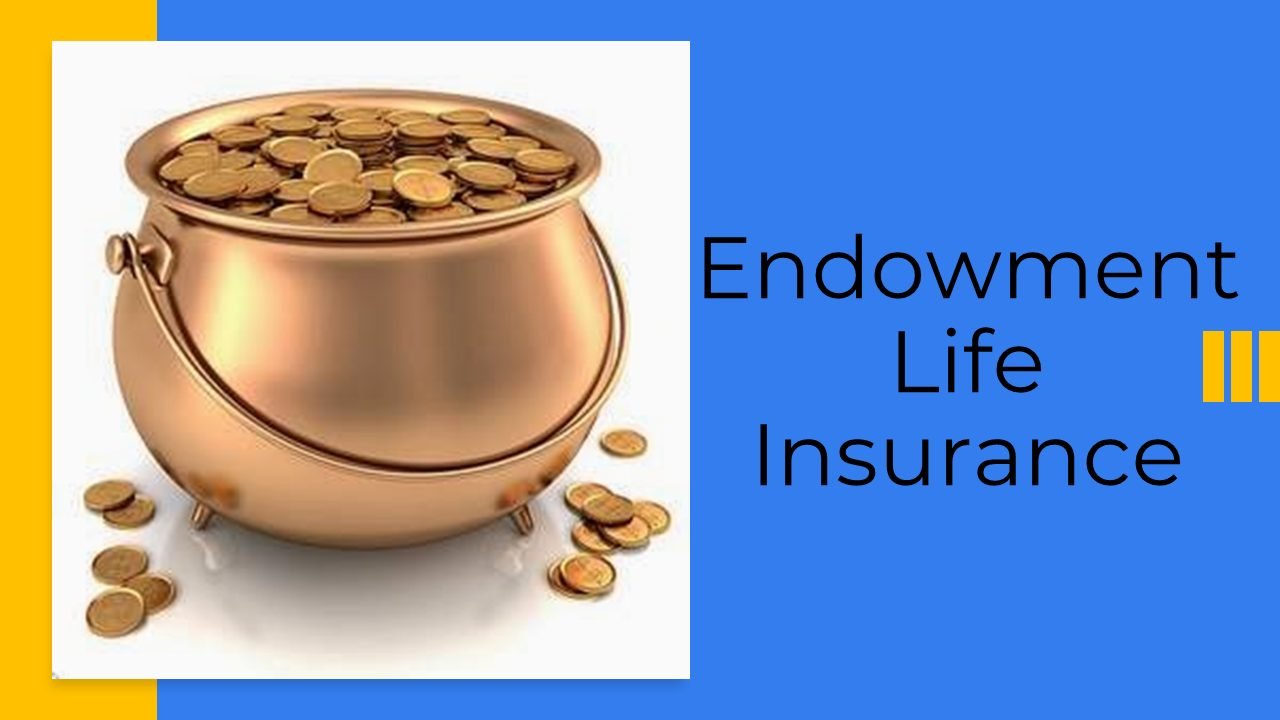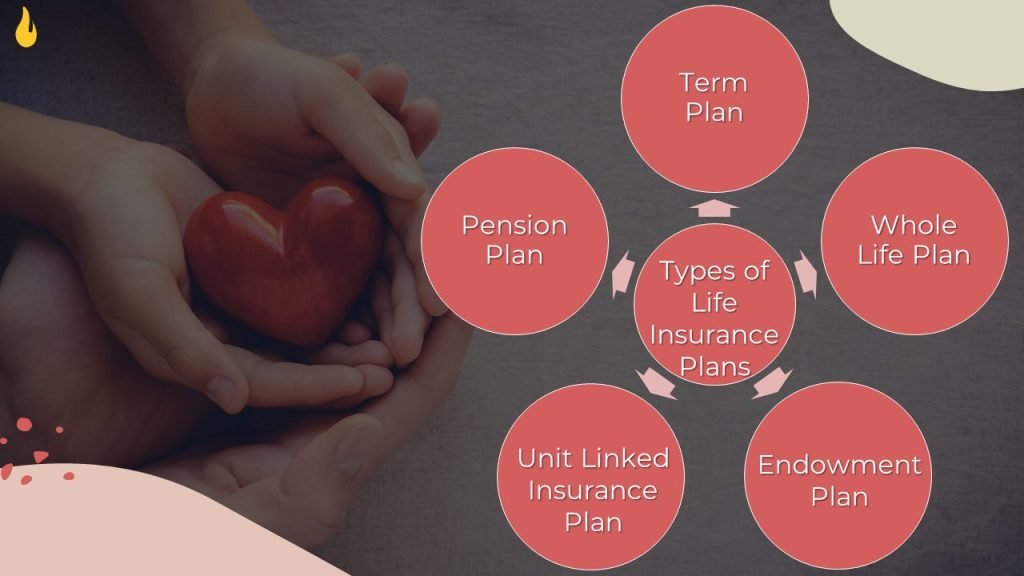Introduction:
As per the government and industry data, at least 100 crore Indians – more than the entire population of Europe are not covered by any form of life insurance.
The reason for this huge gap is the lack of awareness about the various types of Life Insurance Plans available in India.
In this article, we will explore five of the most common types of Life Insurance Plans and how they can help you secure the future of your near and dear ones against unforeseen events. Below are the types of life insurance plans available in India.
Types of Life Insurance Plans in India:
Life insurance policies can be broadly categorized into two main groups: traditional life insurance plans and Unit Linked Insurance Plans (ULIPs). Among the most prevalent conventional life insurance policies, we find Term Insurance, Whole Life Plans, Endowment, and Pension Plans (which can also be Unit Linked). Let’s delve into the specifics of these Types of Life Insurance Plans below.
Term Insurance:

What is Term Insurance?
Term Insurance is the purest form of life insurance. It is the most economical way to protect your family in case of an eventuality. As per IRDA guidelines, all life insurance companies must have term insurance plans in their product range.
These types of life insurance plans come with various duration and premium payment terms. Ideally, there is no return of premiums paid after the completion of the term. However, certain companies offer some unique plans with the return of premiums paid at the end of the policy term.
You can also customize these types of life insurance plans by adding some additional benefits called Riders. Some of the common riders offered by insurance companies are Accidental Death Benefit Rider, Critical Illness Rider, Permanent Disability Rider, Waiver of Premium Rider, etc.
Why Term Insurance?
When the breadwinner of the family dies, it’s challenging for the ones left behind to cope emotionally. And the worst part is that there are also financial issues. However, you could get compensated for the loss of income if you have sufficient term insurance coverage on hand. This prevents your loved ones from being destitute.
How to choose the right Term Insurance Plan?
You must carefully assess your insurance needs by comparing your liquid assets and current/future financial liabilities. You should also factor in your long-term financial goals. Once you calculate the amount of insurance needed, the next step is exploring various available options. For example, you can opt for a policy with a longer duration if you want to leave behind a legacy for your family. Otherwise, you can opt for a term until your dependents are likely to be dependent on your income. Then you can go with a reputed brand, ideally with a high Claim Settlement Ratio.
Whole Life Insurance:

What is Whole Life Insurance?
As the name suggests, the Whole Life Insurance plan covers you for your entire life, usually till age 100. An insured person is covered throughout the policy term.
Although the duration of the policy is very long, you can choose a premium payment term as per your choice and convenience. Most people prefer to pay till the retirement age or till age 60.
Why Whole Life Insurance?
Whole Life Insurance could be the way to go if you want to leave money for your loved ones after you pass on. Payout amounts for these types of life insurance plans are set at the time of purchase and aren’t affected by interest rates or market volatility. In addition, investing in these types of life insurance plans is a good idea since it offers a lot of flexibility to customize the plan to suit your specific needs.
How to choose the right Whole Life Insurance Plan?
When buying whole life insurance, it’s essential to keep in mind that this is a long-term investment, so think about what you might need from the plan years down the road.
In addition to death benefits, there are withdrawal benefits which can be beneficial depending on your situation. The premiums vary greatly depending on how much coverage you’ll be receiving provided by the plan. By evaluating various Whole Life Plans offered by insurance companies, you can get a fair idea of what suits your current and future needs.
Also, it’s essential to look into periods post-retirement where withdrawals can be made from policies if needed and how those withdrawals will affect the policy’s cash value. Finally, consider how much money you want to leave behind for loved ones while choosing the death benefit amount.
Endowment Life Insurance:

What is Endowment Life Insurance?
An Endowment Life Insurance plan is designed to give you a lump sum benefit at maturity, including accrued bonuses. However, if the policyholder doesn’t survive till maturity, the death benefit is paid to his/her nominee, including the sum assured and any accumulated bonuses.
Why Endowment Life Insurance?
If you tend to spend almost everything you earn, then you must consider buying Endowment Insurance. It forces you to save money at regular intervals and build a corpus that can be used to fulfill your long-term financial goals.
Although the returns generated by these Endowment Plans are not very impressive, these types of life insurance plans help you inculcate good saving habits.
How to choose the right Endowment Life Insurance?
Choosing an Endowment Insurance Plan requires you to consider how much money you’ll need to reach a specific goal. Once you know how much you’ll need, you can compare the duration and sum assured of different policies offered by various insurance companies. This will help ensure that you’re making the best decision for your needs.
Unit Linked Insurance Plan (ULIP):

What is ULIP?
The Unit Linked Insurance Plan, commonly called ULIP, offers insurance and investment benefits in one package.
These are types of life insurance plans that allow you to invest in various market-related securities such as equity, debt, and balanced funds and earn more on your investment, so your investments are linked to market fluctuations. Depending on your risk appetite and investment objectives, you can choose different kinds of ULIPs for a better return.
Why ULIP?
ULIPs can be a great way to accumulate wealth and achieve your financial goals. Whether you want to save for retirement or some other significant life event, ULIPs can give you the financial security you desire.
These types of life insurance plans can be very helpful if you’re unfamiliar with the market and don’t have experience investing in stocks. Expert fund managers will take care of your money invested in these types of life insurance plans. You can choose from different funds and decide on the investment strategy you want.
How to choose a ULIP?
Your fund strategy should be designed depending on your goal and risk appetite. For example, if you are looking for higher returns and are willing to take some risk, you can opt for equity funds. And if you are not comfortable taking any risk, then you can opt for a debt fund. And if you are a conservative investor, you can choose a balanced fund.
ULIP also allows you to choose the insurance cover for the premium amount you pay. If you opt for a lower sum assured, you will get higher returns, and if you opt for a higher sum assured, you will get relatively lower returns. You can choose optimal insurance coverage in line with your long-term financial goals.
Retirement Insurance Plan:

What is Retirement Insurance?
A retirement plan or Pension plan is designed to provide financial stability and security during your golden years. Depending on your needs and preferences, retirement policies can be used to care for yourself and your spouse after your retirement. By investing in these types of life insurance plans, you can ensure that you will have the funds necessary to live comfortably during your golden years.
Why Retirement Insurance?
Retirement Insurance is a great way to put aside a small portion of your earnings while you are employed. Then, at a pre-defined retirement age, you get the option to withdraw 1/3 of the accumulated corpus. This amount can be utilized to fulfill your long-cherished dream. The remaining 2/3 of the corpus generates regular payouts, also called a pension. These pension payouts supplement your post-retirement expenses, preventing you from depending on your son or daughter for money.
What makes pension plans even better is that they serve as an estate planning tool because they allow beneficiaries to inherit your contributions (which can continue earning interest) automatically should you pass away before you can start receiving income from the plan yourself.
How to choose a retirement/pension plan?
To choose the best pension plan, you must evaluate various plans in the market and choose the one that suits your requirement. You can select from Immediate Annuity, Deferred Annuity, Plan with/without life cover, etc.
Resources:
https://www.policybazaar.com/life-insurance/articles/types-of-life-insurance/
https://www.coverfox.com/life-insurance/articles/types-of-life-insurance-policies/
Frequently Asked Questions:
Which are the most prevalent types of life insurance plans?
In India, the most common types of life insurance plans include:
Term Insurance
Whole Life Insurance
Endowment Insurance
Unit Linked Insurance Plan (ULIP)
Retirement Plan
Who is IRDAI?
The Insurance Regulatory and Development Authority of India is a regulatory body under the jurisdiction of the Ministry of Finance, Government of India. Its role is to regulate and license the Indian insurance and reinsurance industry.
Do all types of life insurance plans offer guaranteed returns?
Not all types of life insurance plans offer guaranteed returns. You must review the terms and conditions before buying any plan.
Are riders considered types of life insurance plans?
No, riders are not types of life insurance plans themselves. They are optional add-ons that enhance your base life insurance plan.
What are the key advantages provided by various types of life insurance plans?
Here are the key benefits of various types of life insurance plans in India:
1. Insurance Coverage
2. Financial Security
3. Long-Term Savings
4. Investment Opportunities
5. Tax Benefits under Section 80C, 80CCC & 10(10D)
Do I lose all the money if my policy lapses?
If you are not able to pay the premium and your policy lapses, you can revive the policy by paying the balance premium along with the penalty, if any, and submitting a written request for reinstatement of the policy. However, the revival of the policy is subject to the underwriter’s approval.
What is the “free to look” period?
During the free look period, you are allowed 30 days from the date a life insurance policy was delivered to review and evaluate the policy. A policy bought online has 15 days free look period. The insurance company has to refund any premium you paid if you choose to return the policy for any reason during the “free to look” period.
Is LIC safer than other private insurance companies?
All life insurance companies, including LIC, are governed by IRDAI; as such, all life insurance companies have to abide by IRDAI guidelines. So your investment with any private insurance company is as safe as LIC.
How to choose the best insurance company?
It will help if you check out a few things when choosing an insurance company, such as the company’s Claim Settlement Ratio, Solvency Margin, and Quality of Service. By taking these factors into account, you’ll be able to choose the best insurance company for your needs.
How is Claim Settlement Ratio calculated?
Claim Settlement Ration is the percentage of claims settled by insurance providers. It is calculated by using the formula given below.
Claim Settlement Ratio = Number of claims settled / Total number of claims lodged * 100
What are the factors that affect the life insurance premium?
Some of the factors that affect the life insurance premium are as mentioned below.
Age: This is a fundamental factor that impacts the premium. The premium for any given policy is lower for lower ages and higher for higher ages. Hence financial experts advise buying life insurance at a younger age.
Type of Policy: Life Insurance Premium also depends on the type of policy. For example, the premium for a Term Insurance policy is the lowest of all other policy types.
Amount of Coverage: Premium is higher for higher coverage and lower for lower coverage.
Health Profile: Your health profile also impacts the premium. For a healthy individual, a standard premium rate is applicable. Whereas for an unhealthy individual, a higher premium is charged for the same policy. The excess premium charged (also called loading) depends on the longevity and severity of the health condition.
Family History: The health condition of your parents and sibling is also taken into consideration by the underwriters while reviewing your proposal. Any ongoing illness or cause of death of your parents due to major illness can lead to a hike in your premium, or sometimes your proposal might get declined altogether.
Work Profile: If your nature of work exposes you to undue risk to your life, that can also influence your premium. Some of the examples could be mine workers, people working in radiology labs, marine commandoes, etc.
Lifestyle: If you regularly participate in adventure sports like Bungy Jumping, Paragliding, Skydiving, Mountain Biking, Rafting, etc., then you might have to pay an additional premium
Do I need to disclose minor health conditions?
All the information you mention in the life insurance application is used to assess your life expectancy. Hence it is prudent to answer all the questions accurately to the best of your understanding.
Any suppression and / or misrepresentation of material facts may consequently lead to repudiation of the claim.
Hence, all the information, howsoever minor, must be disclosed to avoid complications in the future.
Can I pay my life insurance premium monthly?
Almost all life insurance companies allow you to pay your premium on Annual, Semi-Annual, Quarterly, and Monthly modes. However, if you opt for a monthly mode of payment, you end up paying a higher accumulative yearly premium.
So you should opt for a monthly mode of payment only if you cannot afford to pay your premium Annually. However, switching back to Annual mode is possible when you are able to do so.
Is it mandatory to have Life Insurance in India?
No. It is not mandatory. However, if your family members, viz. parents, spouse, or children, are financially dependent on you, then it is sensible to have life insurance to secure their future.
Is it possible to buy two different types of life insurance plans simultaneously?
Certainly, you can purchase various types of life insurance plans simultaneously.
Which types of life insurance plans offer the most benefits?
The benefits of different types of life insurance plans vary depending on individual circumstances. It is essential to assess your goals carefully and select the type of life insurance plan that best suits your unique situation.
Which types of life insurance plans do not have an expiration date?
Whole Life Insurance Plans do not expire. They provide insurance coverage typically until the age of 100. If the policyholder lives to age 100, he receives the maturity amount.
What is the difference between policies bought online and offline?
There is no difference between policies bought online or offline. However, some companies offer additional discounts for policies purchased online.
Do I get any tax benefits on life insurance premiums paid?
You can claim tax benefits under Sec 80C of the income tax act for the amount of premium paid for any life insurance plan.
Does the nominee have to pay tax on the death benefit received?
The death benefit amount received is tax-free under Income Tax Act, Sec 10(10D).
Is the maturity amount of traditional life insurance plans taxable?
For all traditional life insurance plans issued before 1st April 2023, the maturity proceeds will be tax-free u/s Section 10(10D).
For all traditional plans issued on or after 1st April 2023, the maturity proceeds will be tax-free u/s Section 10(10D) only if the aggregate premium of all the policies does not exceed ₹5,00,000/-, else the maturity proceeds will be taxable.
Is the maturity amount of Unit Linked Insurance Plans taxable?
For all Unit Linked Insurance Plans issued before 1st February 2021, the maturity proceeds will be tax-free u/s Section 10(10D).
For all Unit Linked Insurance Plans issued on or after 1st February 2021, the maturity proceeds will be tax-free u/s Section 10(10D) only if the aggregate premium of all ULIPs does not exceed ₹2,50,000/-, else the maturity proceeds will be taxable.
Conclusion:
We hope you enjoyed reading this blog post and now have a deeper insight into the various Types of Life Insurance Plans available in India. And since you have a better understanding of the pros and cons of different life insurance policy types, it will help you narrow down the options while buying.
If you have any questions, please feel free to Contact Us. We would be happy to assist you in finding the right insurance plan. Thank you for reading.
Disclaimer:
This article provides general information only and does not constitute financial advice. Financial regulations, product terms, and industry guidelines are revised from time to time. While we have made efforts to ensure the accuracy of the information presented, we do not guarantee its completeness or accuracy. We disclaim any liability for loss or damage arising from actions taken based on the information provided in this article. To make informed financial decisions, please do your own research and consult with a qualified financial professional.
SPREAD THE WORD WITH YOUR NETWORK

